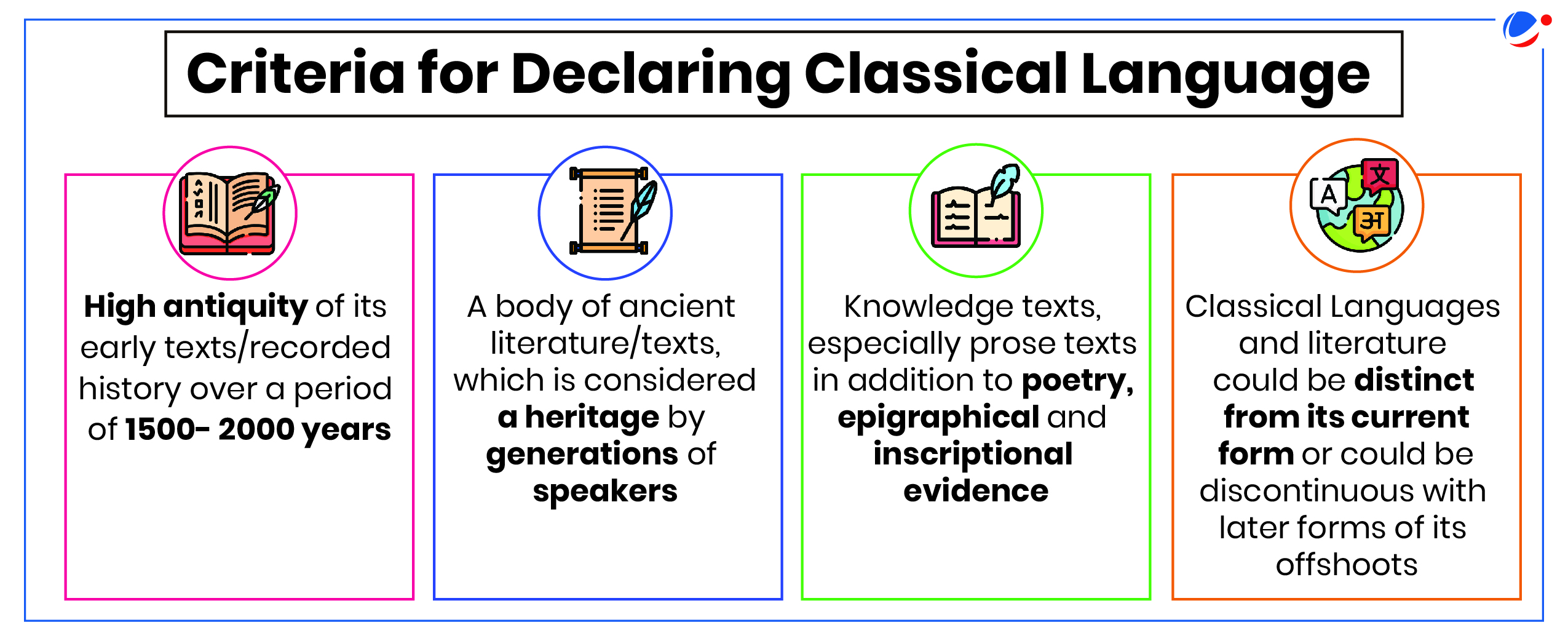Why in the news?
Recently, Union Cabinet has approved Classical Language status to Marathi (Maharashtra), Pali and Prakrit (Bihar, Uttar Pradesh and Madhya Pradesh), Assamese (Assam) and Bengali (West Bengal) languages.
About Classical Language
- Classical Languages serve as a custodian of India's profound and ancient cultural heritage, embodying the essence of each community's historical and cultural milestone.
- In 2004, the Government of India, for the first time, created a new category of languages known as Classical Languages.
- Linguistic Experts Committee (LEC) was constituted by Ministry of Culture under Sahitya Akademi in 2004 to examine the proposed languages for the status of Classical Language.
- Criteria were revised in 2005 as following
- High antiquity of its early texts/recorded history over a period of 1500-2000 years.
- A body of ancient literature/texts, which is considered a valuable heritage by generations of speakers.
- The literary tradition be original and not borrowed from another speech community.
- The classical language and literature being distinct from modern, there may also be a discontinuity between the classical language and its later forms or its offshoots.
- Earlier, six Indian languages namely Tamil (2004), Sanskrit (2005), Telugu & Kannada (2008), Malayalam (2013) and Odia (2014) were accorded the status of Classical Language.
- All these Classical Languages are listed in the Eighth Schedule of the Constitution.
- Criteria for declaring a language as classical was again revised by LEC in 2024 (see infographics).
- 'Original literary tradition' norm was dropped from revised 2005 criteria as LEC observed that it was 'very difficult to prove or disprove original literary tradition as all ancient languages borrowed from each other'.

About New Classical Languages
- Prakrit: It refers to a group of closely related Indo-Aryan languages, whose defining feature was that they were the language of masses as opposed to Sanskrit, which was restricted to elites and high literature.
- Prakrit reflects regional subtypes.
- It was used in the production of various literary texts across the subcontinent from about the second or third century.
- Buddhist literature is in Pali, one of the Prakrits.
- It has been used in various inscriptions of ruling dynasties across South Asia over the first four or five centuries.
- By the time of the Guptas, the Prakrits were standardized and had lost their local character.
Other Important Prakrit Language
|
- Pali: It has traditionally been identified with Magadhi Prakrit. Buddhist philosophical works like Dhammapada and stories like Jātaka Tales are in Pali.
- Pali is known as language of Theravada Buddhist canon. Pali Canon falls into three general categories or pitaka (basket). Together, it is thus known as Tipitaka ("three baskets"). These include:
- Vinaya Pitaka (Discipline Basket), dealing with rules or discipline of Buddhist sangha monastic order.
- Sutta Pitaka (Sayings Basket), largest basket comprising discourses and sermons of Buddha himself, as well as some religious poetry.
- Abhidhamma Pitaka, basket that further elaborates on Buddhist philosophy.
- Marathi: Marathi is an Indo-Aryan language. Modern Marathi descends from Maharashtri Prakrit, a Prakrit dialect used in western India which was the official language of the Satvahanas.
- Earliest evidence of modern Marathi can be traced to a copper-plate inscription found in Satara, dated to 739 CE.
- Bengali & Assamese: Both these languages can find their origin in Magadhi Prakrit, a form of Prakrit popular in East India, and the official language of Magadha court.
Benefits of Conferring Classical Language Status
- Financial assistance: Conferring classical language status will lead to increased financial assistance, promoting research, encourage academic exploration and will help to preserve, promote, and protect the language.
- Documentation and conservation: The status will promote systematic efforts for documenting, conserving, and digitizing manuscripts and ancient texts, ensuring their accessibility to future generations.
- Enhanced cultural identity: It will enhance awareness of the language and strengthen the linguistic identity of speakers, fostering pride in their language's contribution to national and global culture.
- Employment: The tasks of preservation, documentation, and digitisation of ancient texts of these languages will likely generate jobs in archiving, translation, publishing, and digital media.
- For example, cultural heritage linked to these languages can attract visitors, enhancing local economies, providing jobs in event management, tourism, and hospitality.
- Study centres: With classical status, universities and institutions receive funding to set up dedicated centres for the study of these languages, enhancing their visibility and facilitating deeper scholarship.
- For example, Central Institute of Classical Tamil was set up to facilitate the translation of ancient Tamil texts and offer courses in Tamil.
Steps taken to promote classical languages
|
Conclusion
By conferring this status, the government seeks to protect the linguistic milestones of India's diverse cultural landscape, ensuring that future generations can access and appreciate the deep historical roots of classical languages. Also, this move reinforces the importance of linguistic diversity and acknowledges the vital role classical languages play in shaping the nation's cultural identity.



